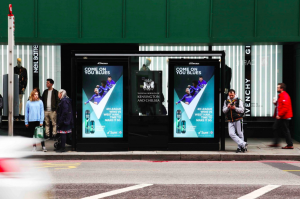
In 2019, half of consumers said they choose news sources based on credibility alone, and that they like and use brands that advertise on trusted sites.* This result, along with countless other surveys, shows that the ad industry needs to step up in their offerings of choice and transparency – it’s clear the stakes have never been higher & 2020 will be the year defined by trust and choice.
That’s where OOH comes into its own; operating in the open, where data-collection and personalisation have the space to be creative and enticing. It is undeniable that DOOH has cemented its place in the ad world. There are no ifs, or maybes, surrounding its effectiveness in delivering intelligent advertising at scale.
But, in the past year or so, talks around the future of OOH have centered on the use of programmatic. Programmatic undeniably has its place in the OOH sector, and can work alongside dynamic, but in terms of building trust – with the consumer, and in turn clients – dynamic has proven its effectiveness time and time again.
Disclaimer: dynamic is nothing new – it already has a huge client base, and its use in DOOH campaigns is growing more and more each year. It’s for this reason the conversation surrounding dynamic needs to be amplified. The lack of representation of dynamic in the media discussions of OOH leaves ad buyers, and brands, with the myth that it’s only being used by big brands on big budget ‘innovative’ campaigns.
That’s far from the truth. Dynamic adds significant value to any campaign plan; it optimises media by delivering contextually relevant messaging. Using smart creative that utilises data to inform these messages, and display them at the right time to the target audience, is not ‘innovative’ it’s just good business.

Studies show that campaigns that use contextual creatives are 48% more effective than those that use non-dynamic**. This is completely unsurprising – consumers are going to connect with, and retain information from, a campaign that is speaking with them on a human level – be it through time, location or weather. Being able to use data to effectively gauge what the consumer needs at that moment, is surely the most effective and efficient way to build trust in your brand.
The effectiveness of dynamic isn’t going unnoticed by brands. Last year BA reinvented some of their sales campaigns using dynamic, powered by the RUSH+ platform. This campaign won a creative tech award. Like their digital ads, it’s informed by search results; using live data to determine creative selection – making the ad contextual and relevant to the consumer.
It seems that once some brands have used dynamic, they continue to do so in future campaigns; the increase in effectiveness on the consumer equals an increase in trust with the client.
This is something Steven Dennison, newly appointed Creative Business Director of DOOH.com has noticed. “When a brand uses dynamic in a campaign, they will often return wanting to do something similar again. For example, Emirates ran a “Dublin to Dubai” weather triggered campaign last year in Ireland; and are re-running it this year with no changes. This is not only hugely cost-effective for them – but shows trust in the product.”
“Once this trust is built, clients are trying more bold and innovative things. We are seeing clients who repeatedly use our products becoming braver, and investing in dynamic – even building bespoke systems for them that have longevity and flexibility in the long term.”
As a result of its successes, brands – and countries – are beginning to tap into the potential that dynamic has to offer. Ireland are making great strides in dynamic, which is evident in the fact that hundreds more screens with these capabilities were added across the country last year (with more planned in 2020). Weather triggered campaigns are becoming more popular – making more use of the media booking; adding more value. Location call out style campaigns are also on the rise. Tesco, M&S, Screwfix, Compare the Market, Specsavers, and many more, continue to push forward with dynamic; providing context to the creative, and increasing brand recognition and reach.
There are dynamic products to suit all campaign budgets – from baseline platforms that allow smart scheduling and instant publishing, to those with API integration (including GPS) and dynamic overlay that are reactive to weather, temperature and traffic. Yet, Posterscope UK published in Jan 2020 that “in the UK and the USA, media spend on dynamically-enabled digital out of home represents just 8% and just less than 5%, respectively, of all DOOH campaigns”. There is clearly room for growth. We have the ability to give intelligent responses to every brief, reflecting dynamic activity to client needs, so why not use it?
As I said before, Dynamic is nothing new – nor is this the first article that has tried to bring it into the spotlight. However, it still seems to be missing in our conversations – whether that be because its negation has created the mystique that surrounds the term, and reserved it for “innovation” only, who knows. But what we do know is that dynamic meets demand, and until it is standardised across the industry, campaigns – both big and small – will be missing their maximum potential.
*Stat taken from news consumption studies by The Drum.
**Stat taken from studies conducted by Posterscope UK on 20 campaigns between 2015 and 2018.

Source: Neil McKenney-DOOH.com

You must be logged in to post a comment Login